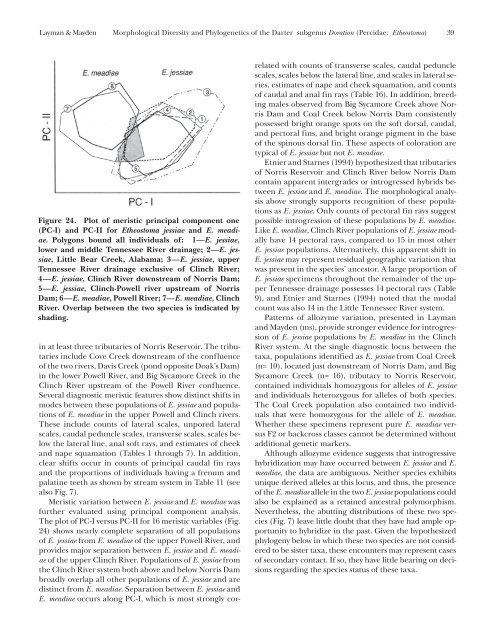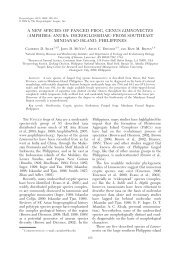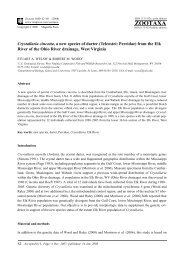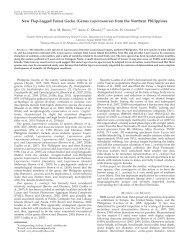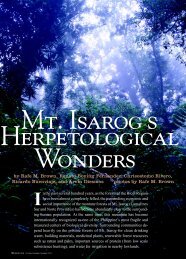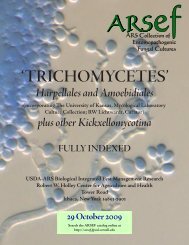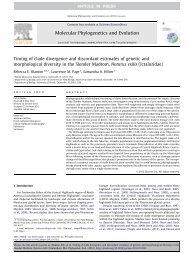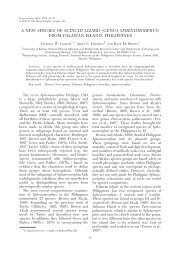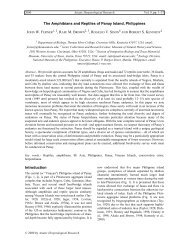(Percidae: Etheostoma), with Descriptions of Five New Species
(Percidae: Etheostoma), with Descriptions of Five New Species
(Percidae: Etheostoma), with Descriptions of Five New Species
- No tags were found...
Create successful ePaper yourself
Turn your PDF publications into a flip-book with our unique Google optimized e-Paper software.
Layman & Mayden Morphological Diversity and Phylogenetics <strong>of</strong> the Darter subgenus Doration (<strong>Percidae</strong>: <strong>Etheostoma</strong>) 39Figure 24. Plot <strong>of</strong> meristic principal component one(PC-I) and PC-II for <strong>Etheostoma</strong> jessiae and E. meadiae.Polygons bound all individuals <strong>of</strong>: 1—E. jessiae,lower and middle Tennessee River drainage; 2—E. jessiae,Little Bear Creek, Alabama; 3—E. jessiae, upperTennessee River drainage exclusive <strong>of</strong> Clinch River;4—E. jessiae, Clinch River downstream <strong>of</strong> Norris Dam;5—E. jessiae, Clinch-Powell river upstream <strong>of</strong> NorrisDam; 6—E. meadiae, Powell River; 7—E. meadiae, ClinchRiver. Overlap between the two species is indicated byshading.in at least three tributaries <strong>of</strong> Norris Reservoir. The tributariesinclude Cove Creek downstream <strong>of</strong> the confluence<strong>of</strong> the two rivers, Davis Creek (pond opposite Doak’s Dam)in the lower Powell River, and Big Sycamore Creek in theClinch River upstream <strong>of</strong> the Powell River confluence.Several diagnostic meristic features show distinct shifts inmodes between these populations <strong>of</strong> E. jessiae and populations<strong>of</strong> E. meadiae in the upper Powell and Clinch rivers.These include counts <strong>of</strong> lateral scales, unpored lateralscales, caudal peduncle scales, transverse scales, scales belowthe lateral line, anal s<strong>of</strong>t rays, and estimates <strong>of</strong> cheekand nape squamation (Tables 1 through 7). In addition,clear shifts occur in counts <strong>of</strong> principal caudal fin raysand the proportions <strong>of</strong> individuals having a frenum andpalatine teeth as shown by stream system in Table 11 (seealso Fig. 7).Meristic variation between E. jessiae and E. meadiae wasfurther evaluated using principal component analysis.The plot <strong>of</strong> PC-I versus PC-II for 16 meristic variables (Fig.24) shows nearly complete separation <strong>of</strong> all populations<strong>of</strong> E. jessiae from E. meadiae <strong>of</strong> the upper Powell River, andprovides major separation between E. jessiae and E. meadiae<strong>of</strong> the upper Clinch River. Populations <strong>of</strong> E. jessiae fromthe Clinch River system both above and below Norris Dambroadly overlap all other populations <strong>of</strong> E. jessiae and aredistinct from E. meadiae. Separation between E. jessiae andE. meadiae occurs along PC-I, which is most strongly correlated<strong>with</strong> counts <strong>of</strong> transverse scales, caudal pedunclescales, scales below the lateral line, and scales in lateral series,estimates <strong>of</strong> nape and cheek squamation, and counts<strong>of</strong> caudal and anal fin rays (Table 16). In addition, breedingmales observed from Big Sycamore Creek above NorrisDam and Coal Creek below Norris Dam consistentlypossessed bright orange spots on the s<strong>of</strong>t dorsal, caudal,and pectoral fins, and bright orange pigment in the base<strong>of</strong> the spinous dorsal fin. These aspects <strong>of</strong> coloration aretypical <strong>of</strong> E. jessiae but not E. meadiae.Etnier and Starnes (1994) hypothesized that tributaries<strong>of</strong> Norris Reservoir and Clinch River below Norris Damcontain apparent intergrades or introgressed hybrids betweenE. jessiae and E. meadiae. The morphological analysisabove strongly supports recognition <strong>of</strong> these populationsas E. jessiae. Only counts <strong>of</strong> pectoral fin rays suggestpossible introgression <strong>of</strong> these populations by E. meadiae.Like E. meadiae, Clinch River populations <strong>of</strong> E. jessiae modallyhave 14 pectoral rays, compared to 15 in most otherE. jessiae populations. Alternatively, this apparent shift inE. jessiae may represent residual geographic variation thatwas present in the species’ ancestor. A large proportion <strong>of</strong>E. jessiae specimens throughout the remainder <strong>of</strong> the upperTennessee drainage possesses 14 pectoral rays (Table9), and Etnier and Starnes (1994) noted that the modalcount was also 14 in the Little Tennessee River system.Patterns <strong>of</strong> allozyme variation, presented in Laymanand Mayden (ms), provide stronger evidence for introgression<strong>of</strong> E. jessiae populations by E. meadiae in the ClinchRiver system. At the single diagnostic locus between thetaxa, populations identified as E. jessiae from Coal Creek(n= 10), located just downstream <strong>of</strong> Norris Dam, and BigSycamore Creek (n= 16), tributary to Norris Reservoir,contained individuals homozygous for alleles <strong>of</strong> E. jessiaeand individuals heterozygous for alleles <strong>of</strong> both species.The Coal Creek population also contained two individualsthat were homozygous for the allele <strong>of</strong> E. meadiae.Whether these specimens represent pure E. meadiae versusF2 or backcross classes cannot be determined <strong>with</strong>outadditional genetic markers.Although allozyme evidence suggests that introgressivehybridization may have occurred between E. jessiae and E.meadiae, the data are ambiguous. Neither species exhibitsunique derived alleles at this locus, and thus, the presence<strong>of</strong> the E. meadiae allele in the two E. jessiae populations couldalso be explained as a retained ancestral polymorphism.Nevertheless, the abutting distributions <strong>of</strong> these two species(Fig. 7) leave little doubt that they have had ample opportunityto hybridize in the past. Given the hypothesizedphylogeny below in which these two species are not consideredto be sister taxa, these encounters may represent cases<strong>of</strong> secondary contact. If so, they have little bearing on decisionsregarding the species status <strong>of</strong> these taxa.


